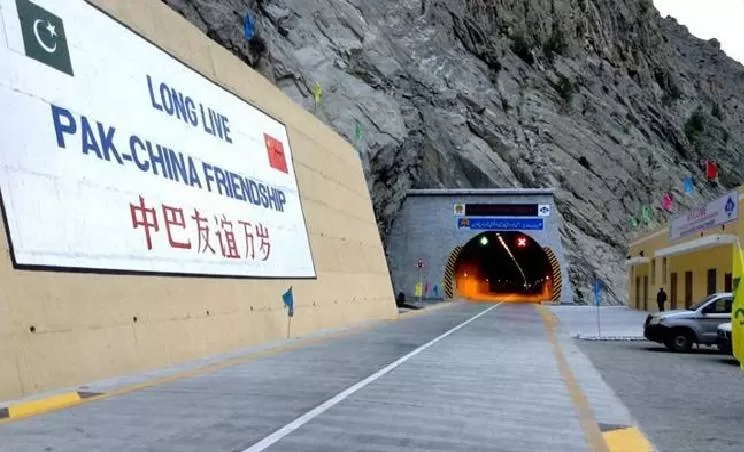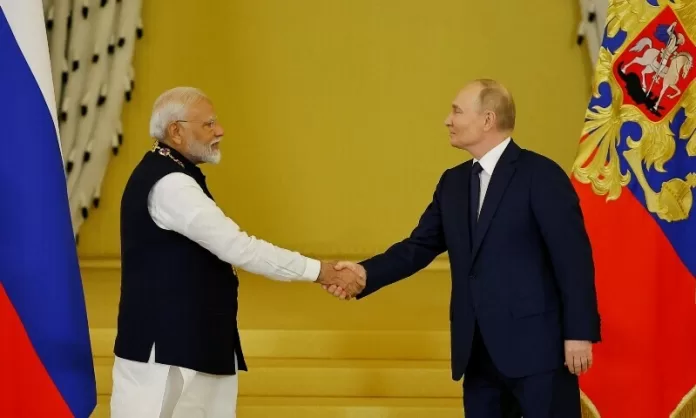India exhibited its capability to keep diverse partners on its side, in an earnest attempt to foment a balanced foreign policy. Prime Minister Narendra Modi’s surprisingly debut visit to Russia, after kick-starting his third-term in office, had categorical messages for Moscow, Washington and Beijing, apart from Brussels.
New Delhi was pushing the envelope of strategic autonomy at a time when unipolarity under the United States is waning and multilateralism is on the rise. The significance was noticed as India went on to lecture on the need for addressing bilateral disputes on the table, in an apt reference to Russo-Ukraine war, and stopped short of condemning Kremlin’s aggression that was for long in demand from Kiev.
Modi, nonetheless, underlined the need to respect International Law, sovereignty and territorial integrity, making it an open and shut case of academic referring. At the same time, he displayed astute inclusivism as he tried to address his country’s energy, scientific, defence and maritime requirements on an equal footing without giving in to the brief that other major powers held for it.
While Modi was conferred with Russia’s highest award, the Order of St Andrew the Apostle, the timing had a mark to make on the regional canvas. The same day, probably, Moscow struck civilian targets and a children’s hospital in Ukraine. That development ironically coincided with the photo-shoot of a Bear’s hug that Modi had with President Vladimir Putin with all smiles.
For many, it was a déjà vu as a similar coincidence was recalled when Prime Minister Imran Khan met Putin merely hours after Russian special forces had marched into Kiev in February 2022. Unlike Pakistan, which had to cave in to American pressure tactics following the Moscow Yatra on the heels of a cipher, it was a passing moment for India that sent down signals that bilateralism has a space to go ahead, and should not be read with real-politick.
There are deep lessons that developing countries can take from this flexing of muscles by India, and embracing of the erstwhile Red Soviets at a time when Delhi is an allied-ally of Washington. Notwithstanding the concerns that the Biden administration signaled over the trip, it was business as usual for both countries. It proved that confidence apparently flows from the barrel of economics and interdependence, making it a first salient feature of self-reliance.
India, while planning the trip, probably had in mind as to how Russia had helped it by sharing nuclear technology when the West was reluctant; and when Pakistan was brokering Sino-US alignment in 1971, how Moscow was forthcoming to sign a defence treaty with Delhi to balance, rather counter-balance, the alliance. Perhaps that is why the US had listed out openly its fears over transfer of sensitive military technologies to the Indian defense sector.
But the merits are overwhelming for India to brush aside its special status with White House and lean towards the Kremlin. Russia is India’s largest arms supplier, and according to the Stockholm International Peace Research Institute, it ranges up to 36% of armament during the years 2019- 2023. Delhi is also expecting the delivery of two remaining S-400 air defense missile systems, and all this is owing to a blanket waiver from the US for procuring weapons. It seems the China-card factor is coming to bite the US itself, as India and Russia fly high in sealing defence deals. On the geo-economics front, Indian oil imports from Russia have jumped to 40% from a meagre 2% before the Russo-Ukraine war, and hints at another area where selective Western sanctions are at work, and how nations that can stand bullying get away with by upholding national interests. Likewise, the visit made a great headway in agreeing to boost bilateral trade up to $100 billion by 2030 from $65 billion, and work for eliminating non-tariff barriers, and make the best use of national currencies.
This for many is another step towards “de-dollarization”, and comes close on the heels of Saudi Arabia wrapping up a 50-year deal on Petro-Dollars, and Pakistan’s Mushahid Hussain Syed at Vladivostok’s BRICS moot recently calling for renewed multilateralism among developing states.

The synopsis of Russia-India realignment, after a hiatus and that too while being in an affair with the United States, could be evaluated in rapidly changing regional dynamics. China is an emerging global power, and its soft image influence has almost outclassed the conventional American perspectives. But in terms of hard power there is a long way to go, but Beijing is countering that aspect with its landmark Belt and Road Initiative (BRI), which makes it homogenous in trade and commerce with five continents. That is one of the reasons why the Western orientation is one of they want is to gang up to counter the Dragon. Thus, if India inches more towards the Bear and hugs it, it is seen in ‘strategic exigency’. India being a trusted Russian friend could be a win-win equation to diffuse the soaring Sino-Russian amalgamation. It is a Machiavellian thought in desperation, and Delhi sits as a prime beneficiary by playing fiddle both for Washington and Moscow. India on the other hand has a valid excuse to forward that the European Union despite being at odds with Russia, and in a state of war over Ukraine, bought a lot of Russian oil, and India itself acted as a connection. Modi’s visit has kicked off a debate in global power corridors that India too is an aspirant to be a pole in a multipolar world, and its growing influence in the Arab and Muslim hemisphere, Africa and namely BRICS, is pitching it for a coveted permanent member at the United Nations Security Council. Thus, its delicate balancing act between the West and Russia, and with China and the United States is a case in point.
It is a foregone conclusion that India will never go to war with China, nor it can stand one, but at the same time it has enough of a leverage to keep the US bogged down in the region by playing the Red Card. So is its new outreach with Russia, and individually with France and Israel who are two other of its indispensable defence partners. This foreign policy wedlock is meant to keep everyone happy, and fingers crossed instantly. The receivable notion, however, is that India has learnt hard to exercise autonomy in its external relations, and it is going places.

India, despite being a Western ally in terms of capitalism and technology, has challenged the dominance of post-Bretton Woods World Order by bringing back Russia in the regional tripartite nexus: India-Russia-China. That is emerging as a threat to dollar-economy and influences many regional realities. The SCO, Eurasia, Central Asia’s rise and their quest for outlets, BRI, CASA-1000 and TAPI, apart from CPEC and Iran-Russo understanding, are entities that are a nightmare for the once resurgent West. India is in all of it, and with the West, too! If Russia manages to come out of the conflict with Ukraine as a military victor, it will seal the fate of regionalism and negate by all means the essence of NATO, and its so-called eastward march. It is a repeat case of the Warsaw alliance that liquidated as Russia took refuge behind the Urals in the hey-days of the Cold War. India by touch-basing Russia, China and the European Union in as many spheres of interaction it can has built a case of invincibility. The upcoming Rules-Based Disorder will see India as a strategic player and one that stakes both in east and west to flex its muscles.
Notwithstanding the cynicism that the neo-alignment is one of symbolism, there is much that will change as India and Russia go on to foment a new trade and tariff nexus, along with a shortened maritime route. The revival of the Soviet era Chennai-Vladivostok maritime corridor is a game-changer in the region, reducing the transit time from 40 to 20 days, buoying Pan-ASEAN and Eurasian trade. It is worth-emulating for developing states to reorient their bilateralism, and walk the path of sovereignty and self-reliance unbothered by major powers’ intrusions. India has played it even, and is good to oscillate between east and west.




